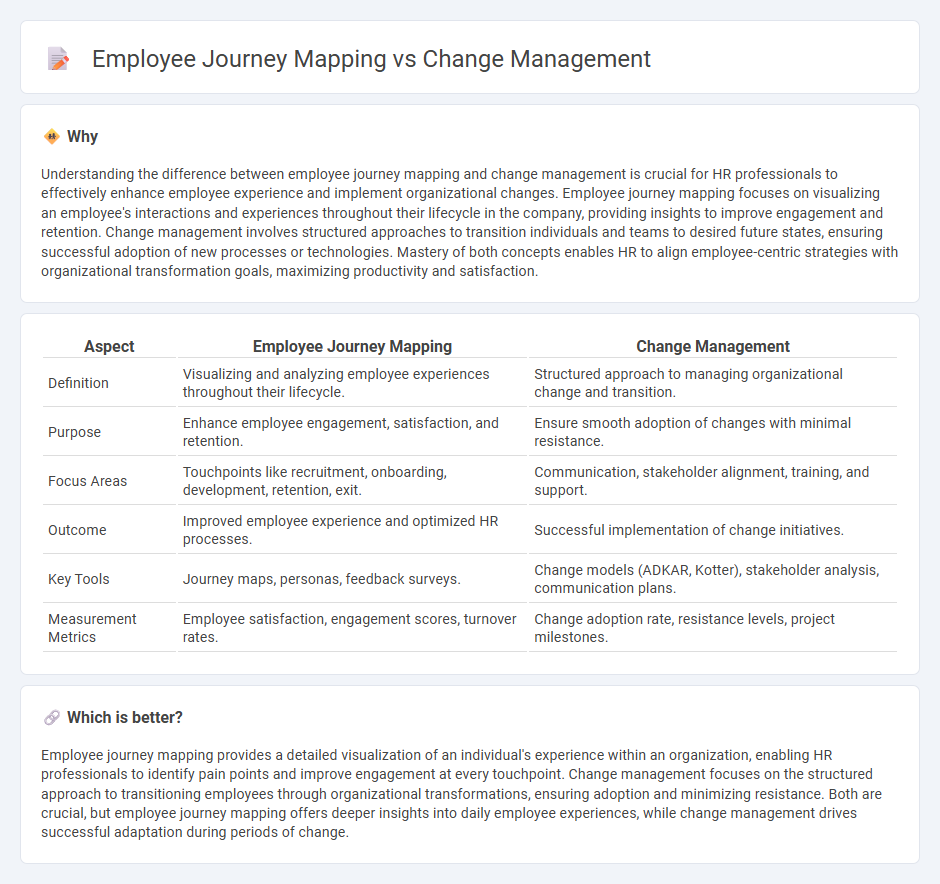
Employee journey mapping focuses on visualizing and understanding employees' experiences and interactions within an organization to enhance engagement and satisfaction. Change management involves structured approaches to transition individuals and teams effectively during organizational shifts, ensuring minimal disruption and sustained performance. Discover how integrating both strategies can optimize workforce adaptation and drive lasting success.
Why it is important
Understanding the difference between employee journey mapping and change management is crucial for HR professionals to effectively enhance employee experience and implement organizational changes. Employee journey mapping focuses on visualizing an employee's interactions and experiences throughout their lifecycle in the company, providing insights to improve engagement and retention. Change management involves structured approaches to transition individuals and teams to desired future states, ensuring successful adoption of new processes or technologies. Mastery of both concepts enables HR to align employee-centric strategies with organizational transformation goals, maximizing productivity and satisfaction.
Comparison Table
| Aspect | Employee Journey Mapping | Change Management |
|---|---|---|
| Definition | Visualizing and analyzing employee experiences throughout their lifecycle. | Structured approach to managing organizational change and transition. |
| Purpose | Enhance employee engagement, satisfaction, and retention. | Ensure smooth adoption of changes with minimal resistance. |
| Focus Areas | Touchpoints like recruitment, onboarding, development, retention, exit. | Communication, stakeholder alignment, training, and support. |
| Outcome | Improved employee experience and optimized HR processes. | Successful implementation of change initiatives. |
| Key Tools | Journey maps, personas, feedback surveys. | Change models (ADKAR, Kotter), stakeholder analysis, communication plans. |
| Measurement Metrics | Employee satisfaction, engagement scores, turnover rates. | Change adoption rate, resistance levels, project milestones. |
Which is better?
Employee journey mapping provides a detailed visualization of an individual's experience within an organization, enabling HR professionals to identify pain points and improve engagement at every touchpoint. Change management focuses on the structured approach to transitioning employees through organizational transformations, ensuring adoption and minimizing resistance. Both are crucial, but employee journey mapping offers deeper insights into daily employee experiences, while change management drives successful adaptation during periods of change.
Connection
Employee journey mapping provides a detailed visualization of an individual's experience within an organization, identifying key touchpoints and potential pain points that impact engagement and productivity. Change management utilizes these insights to design targeted interventions that facilitate smooth transitions during organizational changes, minimizing resistance and enhancing employee adoption. Integrating employee journey mapping with change management strategies ensures alignment between employee needs and company objectives, driving successful transformation initiatives.
Key Terms
**Change Management:**
Change management involves structured approaches to transitioning individuals, teams, and organizations from a current state to a desired future state, emphasizing communication, training, and stakeholder engagement. It aims to minimize resistance and maximize adoption by addressing the emotional and practical aspects of change throughout the organization. Explore how integrating change management strategies can enhance transformation success and support employee adoption.
Communication
Change management emphasizes clear communication strategies to align employees with organizational transformations, ensuring message consistency and reducing resistance. Employee journey mapping focuses on identifying communication touchpoints throughout the employee lifecycle to enhance engagement and satisfaction at each stage. Explore the differences and best practices in communication approaches within change management and employee journey mapping to optimize workforce alignment.
Stakeholder Engagement
Change management emphasizes systematic strategies to involve stakeholders ensuring smooth transitions and acceptance of organizational changes. Employee journey mapping focuses on understanding employees' experiences at each touchpoint to tailor communication and engagement efforts effectively. Discover how integrating both approaches enhances stakeholder engagement by aligning change initiatives with employee needs.
Source and External Links
What is Change Management? Definition & Process - Change management is a structured approach to guiding and supporting people through organizational change by establishing clear objectives, providing training, managing resistance, and ensuring sustainable adoption through monitoring and evaluation.
What is Change Management? - Change management involves planning, communicating, and implementing organizational changes to help people and processes adapt, typically in response to events like mergers, leadership shifts, or technology upgrades.
What is Change Management? Organizational, Process ... - Change management requires defining the change, assessing risks, communicating clearly, and engaging employees throughout the process to ensure successful adoption across all levels of the organization.
 dowidth.com
dowidth.com